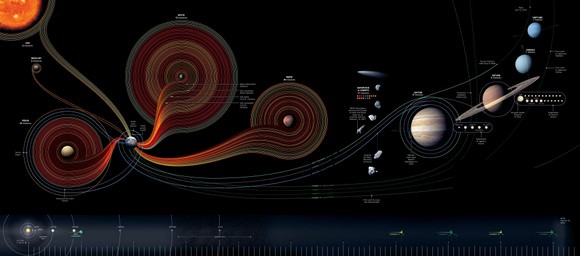[/caption]
National Geographic has put together a really nice zoomable poster on the history of robotic space exploration. It looks a little psychedelic from a distance, but zoom right in and follow the different missions to the various locations in our solar system, and see where the missions currently underway — like New Horizons, on its way to Pluto, and the venerable Voyagers that we hear from occasionally– are presently located. Click on the image to go to National Geographic’s Map of the Day page. Enjoy!
13 Replies to “Amazing Zoomable Poster on 50 Years of Space Exploration”
Comments are closed.


Love seems more attractive than War.
Actually, I wanted to ask why Venus has been more of an interest. It’s a harsh world.
I would say that the interest in Venus is rooted in the “old thinking” that Venus is a twin of the earth. And it’s cloud cover made it more attractive than Mars, because one could actually uncover something. And for today it is worth studying it, because we can learn what can happen to earth if human beings keep on polluting the environment like hell…..
“Love seems more attractive than War.”
Gogo human goodness! 😛
This poster is very educational and looks very easy and interactive to use.Good to show the basics of space exploration to non astronomy or related lovers and enthusiasts.. The dates at he lines of each mision are very usefull.. Graet Job NatGeo…
Can some body tell me where I can get it on JPG format ?
Note to add: As someone pointed out at BadAstronomy, another reason to go to Venus is the much shorter way…. good point…
Here’s a JPEG version
http://www.stevey.com/wp-content/uploads/2009/01/50-years-exploration-huge.jpg
Thanks all. I was reminded on BA that it took quite a while before they realized it is a harsh world. And even so, it shows what could have happened, or still could happen as you say.
Today the best twin must be Titan, which have a surface/atmosphere methane cycle like our water cycle, and even the same type of wind systems. Which is also good to have to figure out climate and climate change.
@ DrFlimmer: As I understand it, the delta-v requirement is the same if one use these new-fangled (?) “interplanetary highways” for transit. But the shorter turnaround time is definitely a benefit.
It strikes me that one could add 1) the higher efficiency of solar panels and 2) the likely unsurmountable problems of making useful landing missions Venus, which makes the missions that much cheaper as well. 🙂
Correction: The delta-v requirement is the same using those “zero-energy” transits _and_ gravity/atmosphere assist braking, depending on relative sun distance compared to Earth. Only half of the problem is getting there…
Tobjorn: I believe you are correct; it’s easy to get to Mercury and Venus, but the trick is getting them to stop once they get there. It’s pretty much the opposite problem they have with getting a probe to the outer planets.
It is the relative speed, as always, that makes things crappy 😉 . In order to go to Venus and Mercury you normally must gain speed, but if you want to go into an orbit you have to lose some of that speed again. To the outer planets it is almost the other way around, but not exactly. You still need to get some speed from somewhere to leave the earth and to go on the way away from the sun. And, yet, the same problem arises, if you want to settle down into an orbit, again: You must lose speed!
Oh, and don’t forget to make the right conversions from miles to meters! 😀
Is this image available in print form? I’d love to have it on my wall!
Also, I wanted to point out a mistake: one of the captions incorrectly states that NEAR Shoemaker landed on asteroid Eris, when it was in fact asteroid Eros.